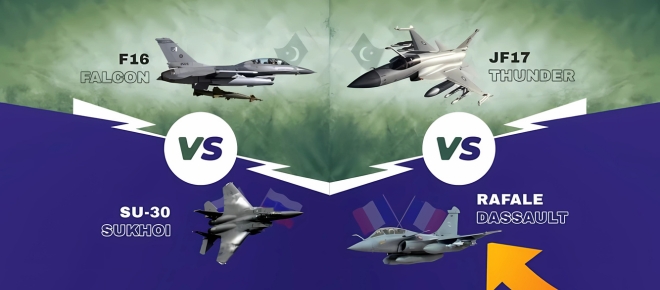Rafale beats F-16 in tech and roles, Su-30 outguns JF-17 in range and power, but JF-17 wins on agility and cost-efficiency.

Rafale and F-16 face off: advanced multirole jets built for speed, agility, and precision strike. Su-30 and JF-17 compared: heavy firepower meets lightweight agility in modern air combat roles.
Here's a comprehensive technical and financial comparison of the Rafale vs. F-16 Fighting Falcon and the Su-30 vs. JF-17 Thunder. This analysis delves into specifications, performance metrics, costs, and market dynamics, providing insights into each aircraft's capabilities and strategic value.

|
Feature |
Dassault Rafale |
F-16 Fighting Falcon |
|---|---|---|
|
Origin |
France |
United States |
|
Engine |
Twin-engine (Snecma M88-4e) |
Single-engine (General Electric F110-GE-129) |
|
Thrust (Afterburner) |
75 kN per engine |
131 kN total |
|
Max Speed |
Mach 1.8 (1,912 km/h) |
Mach 2.05 (2,177 km/h) |
|
Combat Radius |
Approx. 1,852 km |
Approx. 1,370 km |
|
Service Ceiling |
15,240 m (50,000 ft) |
15,240 m (50,000 ft) |
|
Avionics |
RBE2 AESA radar, SPECTRA EW suite |
AN/APG-83 AESA radar (Block 70/72 variants) |
|
Weapons |
Meteor, MICA, SCALP missiles |
AIM-120 AMRAAM, JDAM, various bombs |
|
Hardpoints |
14 |
9 |
|
Crew |
1 or 2 |
1 or 2 |
|
Unit Cost |
$115–$125 million |
$64–$80 million |
Sources: WebFlite, Fighter Jets World, Aerotime

|
Feature |
Sukhoi Su-30MKI |
JF-17 Thunder Block III |
|---|---|---|
|
Origin |
Russia/India |
Pakistan/China |
|
Engine |
Twin-engine (AL-31FP) |
Single-engine (RD-93 or WS-13) |
|
Thrust (Afterburner) |
123 kN per engine |
85 kN total |
|
Max Speed |
Mach 2.0 (2,120 km/h) |
Mach 2.0 (2,470 km/h) |
|
Combat Radius |
Approx. 1,500 km |
Approx. 1,352 km |
|
Service Ceiling |
17,300 m (56,800 ft) |
16,920 m (55,500 ft) |
|
Avionics |
N011M Bars radar, advanced EW systems |
KLJ-7A AESA radar, modern avionics |
|
Weapons |
R-77, R-73, Kh-31 missiles |
PL-15, PL-10, CM-400AKG missiles |
|
Hardpoints |
12 |
11 |
|
Crew |
2 |
1 |
|
Unit Cost |
$45–$50 million |
$25–$32 million |
Sources: EurAsian Times, PakWheels Blog, DefenceTalk
Each aircraft serves specific strategic needs, and the choice between them depends on a country's operational requirements, budget, and geopolitical considerations.
Find all detailed product insights, comparisons, ratings, and user experiences at MBB Reviews—your trusted source!
Comments